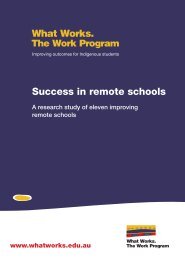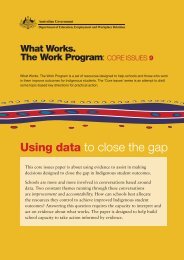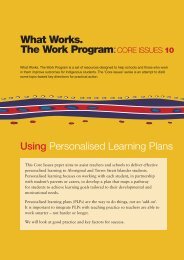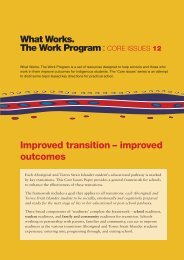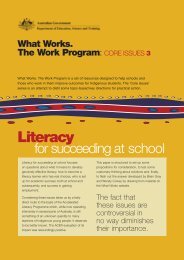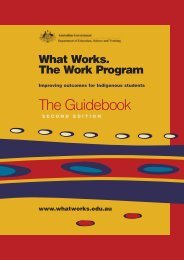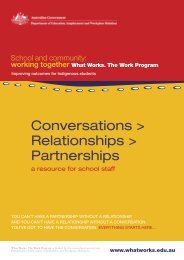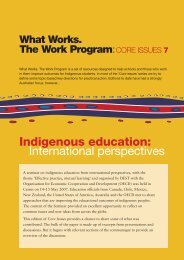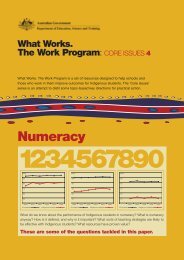Bound for Success Scope and Sequence Statements
Bound for Success Scope and Sequence Statements
Bound for Success Scope and Sequence Statements
- No tags were found...
You also want an ePaper? Increase the reach of your titles
YUMPU automatically turns print PDFs into web optimized ePapers that Google loves.
SPELLINGAbout spellingWhile English spelling may appear quite irregular, studies have revealed it as a spelling system that is quiteregular <strong>and</strong> predictable when examined at deeper levels of language. We now have the benefit of a substantialamount of research, conducted over recent years, around the English spelling − or orthographic – system.English orthography has three layers of in<strong>for</strong>mation about words:• sound• syllabic (patterns within <strong>and</strong> between syllables)• <strong>and</strong> meaningIt is important that words are examined according to the three layers <strong>and</strong> in a way that matches the student’s levelof development.Learning to spellOur development of spelling knowledge mirrors the nature of the spelling system. It begins with the simplestalphabetic level <strong>and</strong> over several years comes to include the syllabic <strong>and</strong> meaning levels.To develop as independent spellers <strong>and</strong> efficient readers, students need to learn how the orthographic systemworks so that they can readily spell words they have never seen be<strong>for</strong>e. To develop this knowledge, all studentsneed to explore <strong>and</strong> learn about the orthographic system in a structured way.Teaching spellingThe Spelling scope <strong>and</strong> sequence provides a list of key orthographic patterns to be explicitly taught in Years 1 to10. Within each year level, the concepts are presented in a teaching sequence that gradually increases incomplexity, building on students’ earlier knowledge. The left column shows concepts to be consolidated from theprevious year level. The right-h<strong>and</strong> column lists new material <strong>for</strong> focussed instruction. The orthographic patternsare colour coded to indicate the progressive stages of orthographic development.Stages of orthographic developmentLetter Name Alphabetic Stage of spellingWithin Word Pattern Stage of spellingSyllables <strong>and</strong> Affixes Pattern StageDerivational Relations Stage of spellingGreek <strong>and</strong> Latin Elements in spellingThis scope <strong>and</strong> sequence provides the required curriculum content—the ‘what’ of teaching spelling. Equallyimportant <strong>and</strong> running parallel is the ‘how’ <strong>and</strong> ‘when’.Students need to develop strategies <strong>for</strong> learning, recalling <strong>and</strong> self-monitoring spelling. For example, use strategiessuch as analogy <strong>and</strong> syllabification to spell words correctly. They need to be able to articulate the patterns ofEnglish spelling <strong>and</strong> be able to apply generalisations to spell words they have not encountered be<strong>for</strong>e.It is also critical to determine the stage in which each student is currently working − so as to teach words <strong>and</strong>patterns that have been selected as developmentally appropriate <strong>for</strong> that student.For further in<strong>for</strong>mation regarding these stages <strong>and</strong> the orthographic patterns, refer to:- Bear, D.R., Invernizzi, M., Templeton, S., & Johnston, F. (2000). Words their way: Word study <strong>for</strong> phonics,vocabulary <strong>and</strong> spelling instruction. Upper Saddle River, NJ: Merrill/Prentice-Hall.- CD ROM: Spelling Improving Student Outcomes (2000). The State of Queensl<strong>and</strong> (Department of Education),Queensl<strong>and</strong> Catholic Education Commission <strong>and</strong> the Association of Independent Schools of Queensl<strong>and</strong>,Brisbane.Students <strong>for</strong> whom English is not the home languageStudents whose home language is not English may find some sight words difficult to learn as they are not alwaysconcrete words (sight words are mostly abstract). While ‘is’ may seem a simple word it is not evident in student’sHL <strong>and</strong> the‘s’ makes a ‘z’ sound. There<strong>for</strong>e students should have lots of opportunities to learn how ‘is’ is used inEnglish spoken <strong>and</strong> written grammar structures be<strong>for</strong>e being expected to learn. Sightwords belonging to wordclasses: Prepositions (in, up, of, <strong>for</strong>), pronouns (she, him, he), auxiliary verbs (are, is, has, had, have), 5W+H(who, what, where, when, why, how) cause difficulties due to limited use in HL <strong>and</strong> there<strong>for</strong>e hold little meaning.This meaning needs to be gradually developed in grammar during speaking, reading <strong>and</strong> writing activities.Some guidance is included in the Spelling scope <strong>and</strong> sequence on other considerations when teaching spelling tostudents <strong>for</strong> whom English is not the home language.For more detailed strategies on this refer to:- the <strong>Bound</strong> <strong>for</strong> <strong>Success</strong> website (www.learningplace.com.au/ea/issu) <strong>and</strong> click on <strong>Bound</strong> <strong>for</strong> <strong>Success</strong>)- Making the Jump Chapter 6.4 <strong>for</strong> strategies to develop ‘sounds’. This is important <strong>for</strong> spelling. (RosalindBerry <strong>and</strong> Joyce Hudson - Catholic Education Commission of Western Australia)- First Steps Writing Map of Development under “Conventions”.<strong>Bound</strong> <strong>for</strong> <strong>Success</strong> <strong>Scope</strong> <strong>and</strong> <strong>Sequence</strong> <strong>Statements</strong> V2 Page 14 Working Document Semester One 2007



